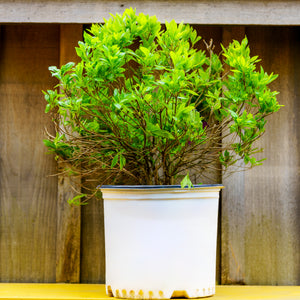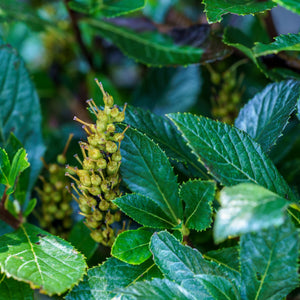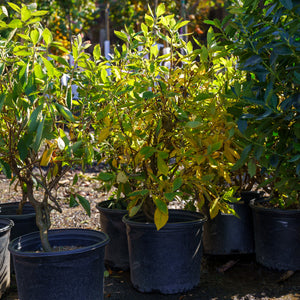The Summersweet Guide
Summersweet (Clethra alnifolia), also known as sweet pepperbush, is a deciduous flowering shrub prized for its fragrant summer blooms, pollinator support, and tolerance for challenging growing conditions. Native to the eastern United States, this adaptable shrub thrives in moist soils, partial shade, and even heavy clay—making it a favorite in naturalistic, woodland, and rain garden designs.
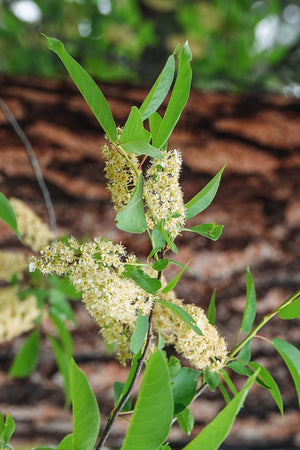
About
Clethra alnifolia typically grows 3 to 8 feet tall with an upright, rounded form and dense branching. Its standout feature is the bottlebrush-like flower spikes that appear in mid-to-late summer when few other shrubs are in bloom. The flowers, usually white or pale pink, are intensely fragrant and attract bees, butterflies, and hummingbirds.
In addition to its floral appeal, Summersweet offers glossy green foliage that turns vibrant yellow in fall. It spreads slowly by suckers, forming thickets over time in ideal conditions. This trait, while useful for erosion control and natural screening, can be managed with pruning or root barrier edging in tighter landscapes.
Popular cultivars include:
- 'Ruby Spice': Deep pink flowers that retain their color longer than other pink forms.
- 'Sixteen Candles': A compact selection with upright, pure white flower spikes.
- 'Hummingbird': Dwarf variety with white flowers and a rounded shape, ideal for small gardens or containers.
- 'Crystalina' (Sugartina®): Compact with strong fragrance and improved form.
- 'Einstein': Dense, upright habit with very fragrant white blooms.
Summersweet’s ability to tolerate wet soil, shade, and salt spray makes it valuable in coastal gardens, rain gardens, and woodland edges where other shrubs may fail.
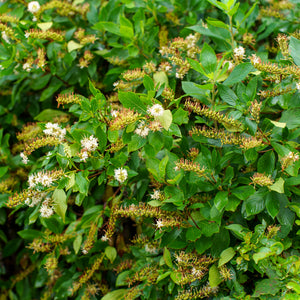
PLANTING
USDA Hardiness Zones: Hardy in Zones 3–9, making it suitable for much of the continental U.S.
Soil: Prefers moist, acidic, well-drained soil. Tolerates heavy clay, sandy soil, and periodic flooding.
Sunlight: Grows in full sun to partial shade. Best flowering occurs in full sun, but foliage stays lush longer in part shade.
Watering: Requires regular watering, especially in sun or during establishment. Extremely tolerant of wet or poorly draining soils.
Spacing: Space plants 3 to 6 feet apart depending on mature size and intended use (hedge, mass planting, etc.).
Planting Time: Plant in spring or early fall to allow roots to establish before summer heat or winter cold.
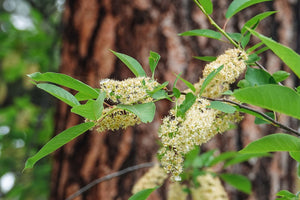
CARE
Watering: Keep soil consistently moist, particularly during the first two seasons. Once established, summersweet is drought tolerant but thrives with regular water.
Fertilizing: Minimal fertilization needed. An annual application of compost or a slow-release acidic fertilizer in spring is usually sufficient.
Pruning: Prune in late winter or early spring before new growth begins. Remove deadwood, shape the plant, or cut back older stems to encourage bushiness. Blooms form on new wood.
Pests and Diseases: Very pest- and disease-resistant. Rarely bothered by deer or rabbits, and not prone to major fungal or insect issues.
Mulching: Mulch with shredded leaves or bark to retain soil moisture, enrich the soil, and reduce weeds.
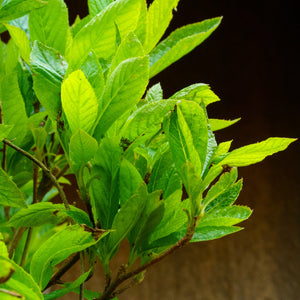
HOW TO USE
Pollinator Gardens: Summersweet’s late-summer blooms provide an essential nectar source for bees, butterflies, and hummingbirds. Plant with Joe-Pye weed, echinacea, or monarda for continuous pollinator support.
Rain Gardens and Wet Sites: Its love of moisture and tolerance of periodic flooding make it ideal for rain gardens, stream edges, or downspout planting beds.
Woodland Borders and Shade Gardens: Combine with ferns, hostas, or Itea virginica to brighten shady beds and woodland margins.
Foundations and Shrub Borders: Use dwarf selections like 'Sixteen Candles' or 'Hummingbird' for smaller spaces near patios, walkways, and foundation beds.
Native and Naturalistic Plantings: Integrates beautifully into native meadows, wildlife gardens, or restoration projects with companion natives like inkberry (Ilex glabra), switchgrass (Panicum), and serviceberry (Amelanchier).
Fall Color Displays: Use Summersweet alongside shrubs with red or purple fall color, such as Viburnum or Fothergilla, to create multi-layered autumn interest.
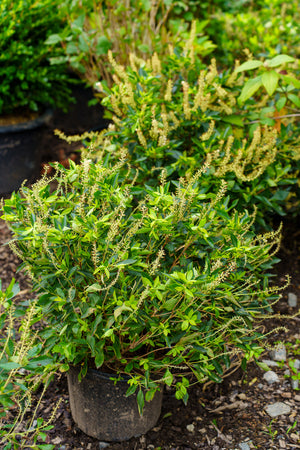
Common Questions
Is Summersweet invasive? No, Summersweet is not invasive. It spreads slowly by suckers but is manageable and native to eastern North America.
How fast does Summersweet grow? Moderate growth rate—typically 12 to 24 inches per year under good conditions.
Do deer eat Summersweet? It is generally considered deer resistant, though young plants may be nibbled occasionally.
Do rabbits eat Summersweet? Rarely. Summersweet is not a preferred food source for rabbits.
Is Summersweet toxic to dogs or cats? No, Summersweet is not known to be toxic to pets.
Is Summersweet evergreen? No, it is a deciduous shrub and drops its leaves in fall.
When does Summersweet bloom? Blooms from mid to late summer, typically July through August depending on location.
When to prune Summersweet? Late winter or early spring before new growth emerges.
How to prune Summersweet? Cut back older stems to the ground to rejuvenate growth or lightly shape the plant as needed. Blooms on new wood.
When does Summersweet leaf out? It is slow to leaf out in spring—often one of the last shrubs to break dormancy.
Do birds like Summersweet? Yes, while not a berry-producing shrub, its dense structure provides shelter, and its flowers attract insect prey for birds.
Does Summersweet need full sun? It tolerates full sun to part shade, with best flowering in full sun and best foliage in partial shade.
Conclusion
Summersweet is a graceful, fragrant shrub that bridges the gap between beauty and function. It thrives in sun or shade, handles wet soil with ease, and fills the garden with sweetly scented flowers when few other plants are blooming. With its adaptability, low maintenance needs, and wildlife value, Summersweet is a worthy addition to gardens of all styles—from formal beds to wild native habitats.
The Summersweet Collection
Sold Out
Sold Out

